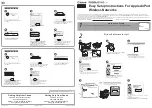
Glossary
GL-5
Cisco Aironet 1300 Series Outdoor Access Point/Bridge Hardware Installation Guide
OL-5048-02
RP-TNC
A connector type unique to Cisco Aironet radios and antennas. Part 15.203 of the FCC rules
covering spread spectrum devices limits the types of antennas that may be used with transmission
equipment. In compliance with this rule, Cisco Aironet, like all other wireless LAN providers,
equips its radios and antennas with a unique connector to prevent attachment of non-approved
antennas to radios.
RSSI
Receive signal strength indicator. A measurement used to help align two antennas for the strongest
received signals.
S
spread spectrum
A radio transmission technology that spreads the user information over a much wider bandwidth
than otherwise required in order to gain benefits such as improved interference tolerance and
unlicensed operation.
SSID
Service Set Identifier (also referred to as Radio Network Name). A unique identifier used to
identify a radio network and which stations must use to be able to communicate with each other
or to an access point. The SSID can be any alphanumeric entry up to a maximum of 32 characters.
T
transmit power
The power level of radio transmission.
U
UNII
Unlicensed National Information Infrastructure—regulations for UNII devices operating in the
5.15 to 5.35 GHz and 5.725 to 5.825 GHz frequency bands.
UNII-1
Regulations for UNII devices operating in the 5.15 to 5.25 GHz frequency band.
UNII-2
Regulations for UNII devices operating in the 5.25 to 5.35 GHz frequency band.
UNII-3
Regulations for UNII devices operating in the 5.725 to 5.825 GHz frequency band.
unicast packet
A single data message (packet) sent to a specific IP address.
W
WEP
Wired Equivalent Privacy. An optional security mechanism defined within the IEEE 802.11
standard designed to make the link integrity of wireless devices equal to that of a cable.
workstation
A computing device with an installed client adapter.






































